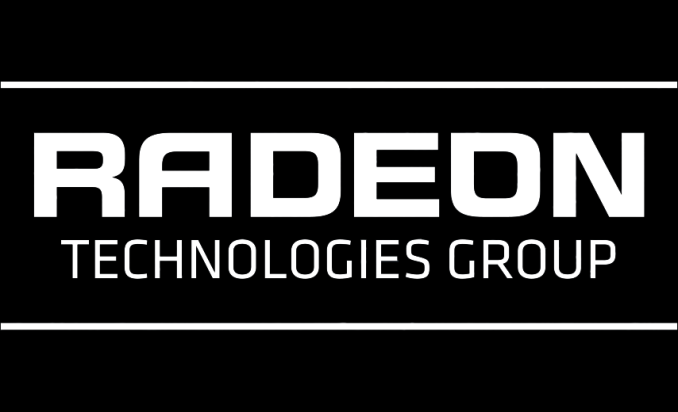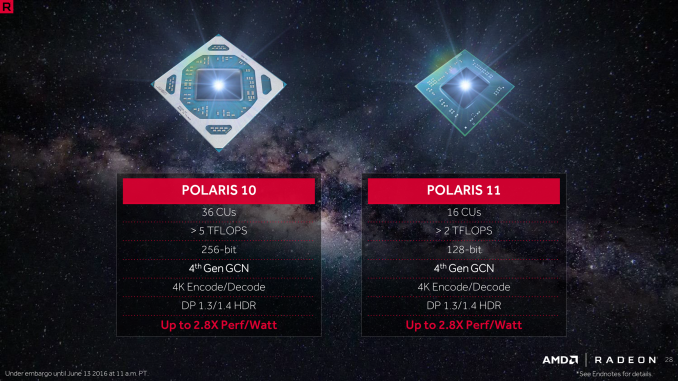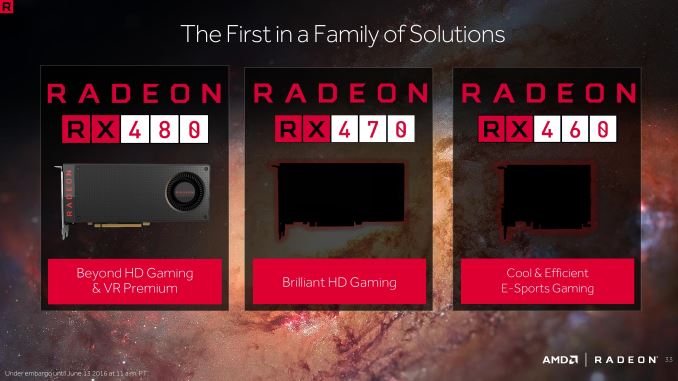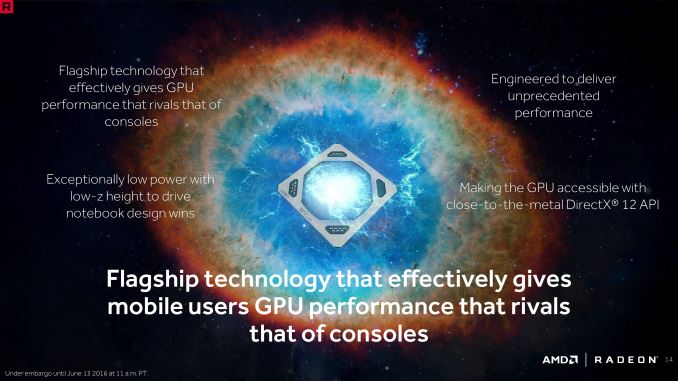A Bit More on AMD’s Polaris GPUs: 36 & 16 CUs
by Ryan Smith on June 15, 2016 8:30 AM EST
Along with this week’s teaser of the forthcoming Radeon RX 470 and RX 460 at E3, AMD also held a short press briefing about Polaris. The bulk of AMD’s presentation is going to be familiar to our readers who keep close tabs on AMD’s market strategy (in a word, VR), but this latest presentation also brought to light a few more details on the company’s two Polaris GPUs that I want to quickly touch upon.
First and foremost, AMD’s presentation included a slide with pictures of the two chips, and confirmation on their full configurations. The larger Polaris 10 is a 36 CU (2304 SP) chip, meaning that the forthcoming Radeon RX 480 video card is using a fully enabled chip. Meanwhile the smaller Polaris 11 (note that these pictures aren’t necessarily to scale) packs 16 CUs (1024 SPs). This puts it a bit below Pitcairn (20 CUs) before factoring in GCN 4’s higher efficiency. Meanwhile as is common for these lower-power GPUs, AMD’s slide also confirms that it features a 128-bit memory bus.
AMD is expecting Polaris 11 to offer over 2 TFLOPs of performance. Assuming a very liberal range of 2.0 to 2.5 TFLOPs for possible shipping products, this would put clockspeeds of a high-end Polaris 11 part at between 975MHz and 1220MHz, which is similar to our projections for RX 480/Polaris 10. Note that AMD has not yet announced any specific product using Polaris 11, however as we now know that RX 470 is a Polaris 10 based card, it’s safe to assume that RX 460 is Polaris 11, and the over-2 TFLOPs projection is for that card.
Second, briefly mentioned in AMD’s press release on Monday was the low z-height of at least Polaris 11, and it pops up in this slide deck again. There was some confusion whether z-height referred to the laptop or the chip, but the slide makes it clear that this is about the chip. So it will be interesting to see how thin Polaris 11 is, how that compares to other chips, and just what manufacturers can in turn do with it.



















98 Comments
View All Comments
Ranger1065 - Thursday, June 16, 2016 - link
A standard Anandtech apologist remark. While there may yet be a grain of truth to the old "no one goes into the details like Anandtech does" defense, truth be told, this is an inexcusable ball drop of immense proportions.As I have said previously, by the time they finally publish the EPIC ARTICLE, (and after this long one wonders if they ever will or even care about doing so) no amount of that special Anandtech sauce will be able to redeem it.
News that old interests no-one.
RIP GPU SECTION.
trinibwoy - Thursday, June 16, 2016 - link
Not to mention the MIA 960 review. It's the end of an era.ikjadoon - Wednesday, June 15, 2016 - link
Interestingly, TechReport (another relatively high-quality publication) also has not released their GTX 1080 review....very very interesting!HighTech4US - Wednesday, June 15, 2016 - link
Both sites have lost high end personnel.I wonder if that is the primary reason for the delays.
CaedenV - Wednesday, June 15, 2016 - link
I love how eSports have become synonymous with 'cheap budget cards' over this last year.ikjadoon - Wednesday, June 15, 2016 - link
Well, it makes sense. Aren't the big eSports games DOTA2 and LoL, which are hardly GPU-intensive?stardude82 - Wednesday, June 15, 2016 - link
if an RX 460 is inline with a GTX 950/R7 370, it should handle pretty much any eSport game at 1080p @ 60fps maxed out. The only exception would be Overwatch which is very new and with settings only turned down a notch.nightbringer57 - Wednesday, June 15, 2016 - link
It does actually make sense.We've seen actual budget cards become increasingly weaker compared to the high end. Meanwhile, somewhat undemanding games have become the bread and butter of esports, since to gain momentum, developers of esports oriented games target markets that do not traditionally have big budgets to invest into their computers. In turn, it's only logical that GPU manufacturers would release cheaper, sufficient cards for said markets. They do actually correspond to a reality and I don't think it's purely a marketing ploy.
Qwertilot - Wednesday, June 15, 2016 - link
It isn't even outright about being cheap. There are definite characteristics for this sort of market. Raw speed isn't super crucial, but I guess you still want enough to run the odd console port at half sane settings.The crucial things are stuff like very low TDP, small size and very quiet coolers.
SoccerVolt - Wednesday, June 15, 2016 - link
Does this confirm some additional specs for Project Scorpio in any way? Or can additional specs be derived from this presentation?